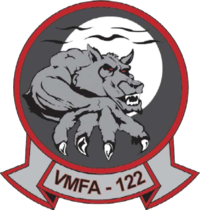VMF-122
| Marine Fighter Attack Squadron 122 | |
|---|---|

VMFA-122 Insignia
|
|
| Active | March 1, 1942–present |
| Country |
|
| Branch |
|
| Type | Fighter/Attack |
| Role |
Close air support Air interdiction Aerial reconnaissance |
| Part of |
Marine Aircraft Group 31 2nd Marine Aircraft Wing |
| Garrison/HQ | Marine Corps Air Station Beaufort |
| Nickname(s) | Werewolves (January, 2008-present) Crusaders (1957-January 4, 2008) Candystripers (WWII) Werewolves (WWII) "The Last Blue Collar Squadron" |
| Tail Code | DC |
| Mascot(s) | Mach Altus |
| Engagements |
World War II * Battle of New Georgia Vietnam War Operation Desert Storm Operation Iraqi Freedom |
| Commanders | |
| Commanding Officer | N/A |
| Executive Officer | N/A |
| Sergeant Major | N/A |
| Notable commanders |
Col. Gregory "Pappy" Boyington MGen. Marion E. Carl LtCol. John Fogg |
| Aircraft flown | |
| Fighter |
F4F Wildcat F4U Corsair FH-1 Phantom F2H Banshee F6F Hellcat F9F Panther FJ Fury F-8 Crusader F-4 Phantom F/A-18A/C Hornet |
Marine Fighter Attack Squadron 122 (VMFA-122) is a United States Marine Corps F/A-18 Hornet squadron. The squadron, known as the "Werewolves", is based out of Marine Corps Air Station Beaufort, South Carolina and fall under the command of Marine Aircraft Group 31 (MAG-31) and the 2nd Marine Aircraft Wing (2nd MAW). Their traditional call sign is "Nikel".
Conduct anti-air warfare and offensive air support operations in support of Fleet Marine Forces from advance bases, expeditionary airfields, and aircraft carriers, and to conduct such other air operations as may be directed.
Marine Fighter Squadron 122 (VMF-122) was commissioned on March 1, 1942 at Camp Kearny in San Diego, California. Outfitted with the F4F Wildcat, the squadron, then known as the "Candystripers", saw their first combat tour in October 1942. During this tour they were part of the Cactus Air Force at Henderson Field and also operated out of Espiritu Santo. In April 1943, while under the command of Major Pappy Boyington, the squadron transitioned to the F4U Corsair and accounted for 35½ kills. The squadron's first combat tour ended on July 23, 1943 after which they returned to Marine Corps Air Station Miramar on August 16. For the next year after their return to the States, the squadron was reorganized and retrained at Marine Corps Air Station El Centro, California.
For its second tour, VMF-122's flight echelon embarked upon the escort carrier USS Hollandia in July 1944 while the ground echelon steamed out on the USS Tryon. Beginning in October 1944 both echelons would be reunited when they were reunited and began operating from an airstrip on Peleliu. At times they provided close air support for Marines during the Battle of Peleliu at distances of just over 1000 yards from where they took off. The squadrons ability to provide napalm and rockets, both new weapons systems, greatly aided in the destruction of the last Japanese strongholds on the island. For the remainder of the war they remained on the island conducting combat operations until August 1945.
...
Wikipedia
